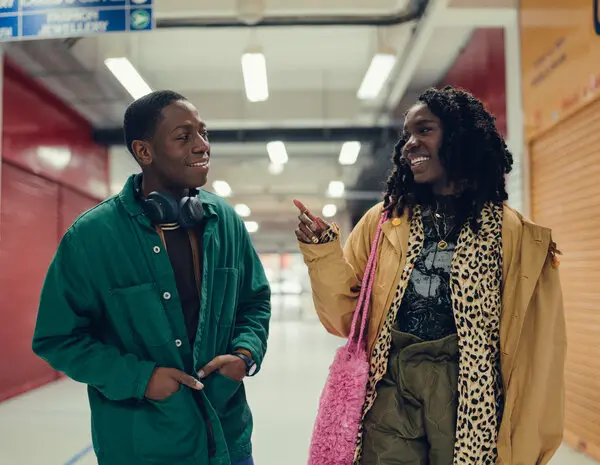Rating: 4/5
“Rye Lane,” director Raine Allen-Miller’s 2023 feature debut, is a charming romantic comedy-drama set in South London. The film follows two strangers, Dom (David Jonsson) and Yas (Vivian Oparah), as they meet through a mutual friend and begin to fall for each other over the course of a day-long adventure. Dom is still devastated by the messy end to his long-term relationship while Yas attempts to hold her head up high as she navigates her own complicated breakup. The story of a chance encounter turning into a loving relationship is certainly not original, but the film still stands out with its bright color palette and unique execution of the cliched concept.
I was quickly struck by how playful the film is. The film is full of dry humor that draws unexpected, genuine laughs out of its audience. It doesn’t take itself too seriously, and that’s what seems to make the punchlines land.
The actors are able to seamlessly transition between being strangers and being in love in the span of a day, despite the two main characters being near-opposites. Jonsson and Oparah play off each other well and make the near-instant love feel entirely natural. However, the characters can still feel somewhat stereotypical and one-dimensional. Dom is a caricature of a person post-breakup, breaking into tears at random intervals. Yas falls into the manic-pixie-dream-girl trope, with her cool demeanor and attempts to make Dom shake off his slump. However, their characters do become more nuanced as the movie goes on. For instance, Yas is able to reveal some vulnerability underneath her careless attitude. Nonetheless, the simplistic characterizations early on make many of their actions, including Yas’ vulnerability, predictable.
Accompanying the wholesome script is a world of color. Nearly every scene in this movie, including the opening scene of Dom crying in a bathroom stall, is spectacularly colorful. The costume designers and set designers doused the film and its characters in flashy shades, but in a way that masterfully makes it all work together. The color choices don’t add to the depth of the film, but they certainly make it more engaging.
Additionally, music is important to Dom and Yas, and seemingly to the creators of “Rye Lane” as well, because the soundtrack is fantastic. Songs like “Rollerblades” by Kwes or “Memories” by Blue Lab Beats and other more obscure artists fit perfectly with the quirky, indie feel of the film. The only downside to the music is that the song playing during the end credits is unreleased, and thus very difficult to find.
One of the most unique aspects of “Rye Lane” is the cinematography. The variation of camera angles kept the film engaging. In particular, the film’s approach to flashbacks was especially unique. Having the characters continue their current conversation while physically present in a past moment elevated the scene with the characters’ quips.
On a more impactful note, the film is able to do justice to its diverse cast. “Rye Lane” is often cheesy and cliche, but it gives people of color — who are not often represented, especially in genres like these — a chance to experience all those campy tropes. Beyond that, the film avoids tokenizing or stereotyping its actors; the film is able to expertly balance between not mentioning race and not making race the center of the plot. For instance, hip-hop pops up throughout the film and, with its themes surrounding racism and oppression, the music connects many of the Black characters without any of them needing to talk about those topics explicitly. In the universe that the writers have created, race gives context and color and depth to the world, but the characters are not bound by it.
“Rye Lane” is by no means profound or entirely unique, but it’s an undeniably fun watch that no one will regret seeing. Besides, who doesn’t like the guaranteed happy endings that romantic comedies provide?

